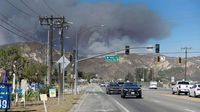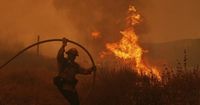On the afternoon of August 7, 2025, a fast-moving wildfire dubbed the "Canyon Fire" erupted near Lake Piru, a scenic reservoir about 50 miles northwest of downtown Los Angeles. What began as a small blaze quickly transformed into a major emergency, forcing thousands of Southern California residents to flee their homes as flames tore through the rugged landscape of Ventura and Los Angeles counties.
According to the New York Times, the fire was first reported around 1:30 p.m. near the 6700 block of Holser Canyon Road, southeast of Lake Piru. Within just a few hours, the blaze had ballooned from 30 acres to over 1,000 acres, driven by a dangerous combination of triple-digit heat, bone-dry vegetation, and steep, inaccessible terrain. By the evening, authorities reported that the fire had scorched nearly 5,400 acres, or about 7.6 square miles, and was still spreading eastward toward Los Angeles County.
Fire officials moved quickly to issue evacuation orders and warnings. More than 16,000 residents across Ventura and Los Angeles counties were affected, with at least 2,700 people in Los Angeles County alone required to evacuate immediately. The evacuation orders covered at least 10 zones, including communities in Santa Clarita, Hasley Canyon, and Val Verde. In Ventura County, the evacuation zones were more sparsely populated, but 56 people were still evacuated from the Lake Piru recreation area, and Piru Canyon Road was closed at Main Street. The Lake Piru Recreation Area itself was shut down and placed under a mandatory evacuation order, as reported by the Ventura County Star.
"Extreme heat and low humidity in our north county have created dangerous conditions where flames can spread with alarming speed," cautioned Los Angeles County Supervisor Kathryn Barger in a public statement. She urged residents to take evacuation orders seriously: "If first responders tell you to leave, go—without hesitation." The Red Cross responded by opening a shelter at College of the Canyons in Santa Clarita, while Pierce College prepared stalls for displaced horses and livestock.
As the sun set on August 7, at least 400 firefighters were on the ground battling the Canyon Fire, supported by a fleet of helicopters, fixed-wing aircraft, and air tankers dropping water and fire retardant from above. Reinforcements were summoned overnight as the heat lingered near 100 degrees Fahrenheit and the humidity hovered in the mid-teens, making the job even more perilous. "Firefighters are working incredibly hard through steep terrain in hot weather with very dry fuels," Ventura County Fire Department spokesperson Andrew Dowd told the Ventura County Star. The unified command between Ventura and Los Angeles counties coordinated the massive response, with additional hand crews, engines, and bulldozers requested to bolster containment efforts.
By the morning of August 8, authorities reported some progress: containment had inched up to 25%, with the overall burned area mapped at 5,370 acres. No residential homes had been damaged or destroyed, though two minor outbuildings were lost. The fire's head remained most active in the Hasley Canyon area, but firefighters had managed to reinforce key containment lines overnight, taking advantage of slightly cooler weather.
The Canyon Fire was just one front in a much larger battle against wildfires raging across California and the broader western United States during a record-setting heat wave. The Gifford Fire, burning northwest of Los Angeles County in Santa Barbara and San Luis Obispo counties, had by August 8 torched 155 square miles (about 99,200 acres), making it the largest wildfire in California so far this year. It was threatening hundreds of homes and had injured at least three people, according to USA TODAY. The Gifford Fire, which started from at least four smaller fires along State Route 166 on August 1, forced major road closures and was only 15% contained as of August 8.
The Rose Fire in Riverside County, south of Palm Springs, was also burning out of control, having scorched 1,690 acres and threatened nearly 500 structures, with containment at 30%. Meanwhile, in Colorado, the Lee Fire had become the state's largest wildfire of the year, burning an estimated 45,000 acres amid the same relentless heat wave.
California's 2025 wildfire season has already been marked by devastation. Earlier in the year, the Palisades and Eaton fires ignited in January, whipped into infernos by record winds and drought conditions. The blazes swept through both working-class neighborhoods and luxury cliffside homes, destroying thousands of residences. Officials attributed 31 confirmed deaths to those fires, though a recent study suggested the real toll could be as high as 440. The financial cost was staggering—an estimated $65 billion in losses, making those fires the costliest in recorded U.S. history, as reported by USA TODAY.
The environmental and health impacts of these blazes have been severe. The Ventura County Air Pollution Control District issued an air quality watch, warning that the Canyon Fire could create unhealthy conditions in Piru, Santa Paula, Fillmore, and other nearby communities. Smoke and ash from wildfires contain tiny particles that can damage the lungs and heart, prompting officials to recommend that residents avoid strenuous outdoor activity, use air conditioners in recirculation mode, stay indoors, and wear N-95 masks if working outside.
The causes of the Canyon Fire and the other major blazes remain under investigation. However, fire officials and meteorologists have pointed to a dangerous mix of persistent drought, high grass loads, weakening coastal moisture, and record-setting summer heat as key factors fueling the state's wildfire crisis. Cal Fire, California's firefighting agency, warned in its seasonal outlook that "fire potential across California is expected to increase steadily through summer." The agency noted that Southern California's threat is "driven by persistent drought, high grass loads, and weakening coastal moisture," while Northern California faces a "developing flash drought and early-season dryness."
Globally, the economic toll of natural disasters—including the Los Angeles wildfires—has been immense. According to Zurich-based reinsurance giant Swiss Re, natural disasters caused $135 billion in economic losses worldwide in the first half of 2025, with California's wildfires playing a significant role in that figure.
For now, as fire season intensifies and the state braces for more hot, dry weather, officials continue to urge residents to remain vigilant, heed evacuation orders, and stay informed through local emergency alerts and official channels. The Canyon Fire stands as another stark reminder of the growing threat posed by wildfires in California's new era of climate extremes.


